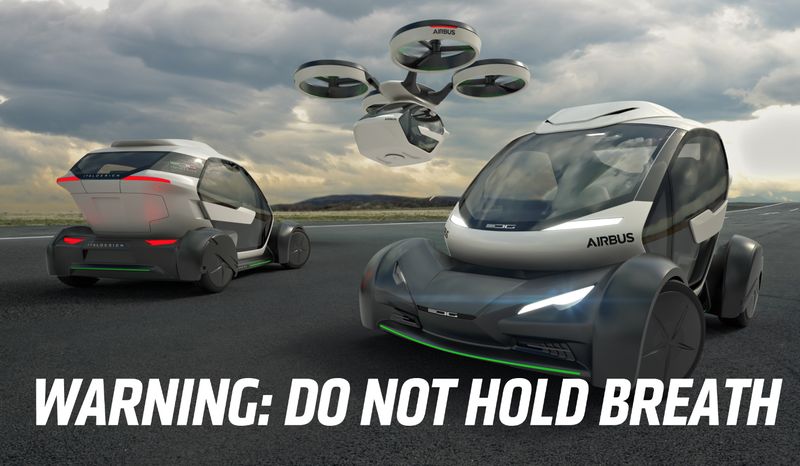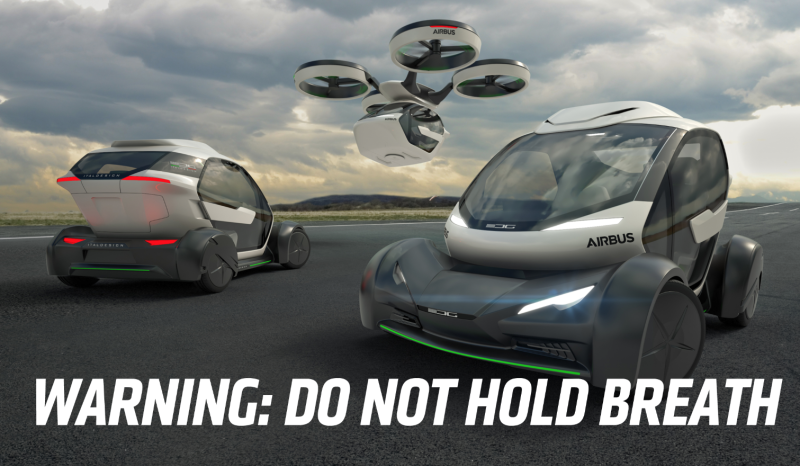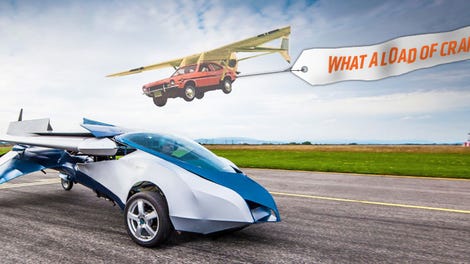
Airplane-maker Airbus and legendary coachbuilder Italdesign have teamed up to make a novel flying-car concept called Pop.Up that, like all flying car concepts, is just two years away from never fucking going to happen.
Advertisement
Someday very soon, it’s likely that you sure as shit won’t be buzzing around the city in one of these innovative little designs.
That’s sort of too bad, because the fundamental concept behind this particular flying car is a little more viable and clever than the usual flying car concept. I mean, not much more viable, since there’s still the issues of battery life while airborne, managing many individual flying vehicles over a congested city, dealing with minor mechanical and accident issues without plummeting out of the sky, untrained drivers/pilots, and more.
What is sort of novel is the design conceit of having one passenger module that mates to either a drone-like quadcopter air-travel unit or a small ground-based wheeled vehicle unit. That part I like, and I think has some possible potential in other contexts.
Here’s how Airbus and Italdesign describe the system:
Advertisement
At the heart of the concept is a capsule: designed to accommodate passengers. This high-tech, monocoque carbon-fibre cocoon measures 2.6 metres long, 1.4 metres high, and 1.5 metres wide. The capsule transforms itself into a city car by simply coupling to the ground module, which features a carbon-fibre chassis and is battery powered.
For megacity journeys with high congested traffic, the capsule disconnects from the ground module and is carried by a 5 by 4.4 metre air module propelled by eight counter-rotating rotors. In this configuration, Pop.Up becomes a urban self-piloted air vehicle, taking advantage of the third dimension to get from A to B efficiently whilst avoiding traffic congestion on the ground.
Once passengers reach their destination, the air and ground modules with the capsule autonomously return to dedicated recharge stations to wait for their next customers.
The little car module has two electric motors making a combined 80 horsepower, and has a range of 80 miles. The flying unit has four motors making 182 HP, with a range of about 60 miles. They say it’ll recharge in 15 minutes, but that number seems to be extracted ex recto.
Having at least the air part piloted autonomously is a good idea, provided everything works and no sensors get compromised and everything like that, but there’s still a lot of hand-waving around the logistics of how these flying units would pick up the passenger modules, what would happen to the wheeled car chassis when the module gets snatched up into the air, who or what manages the various propulsion elements, and so on.
Design-wise, there’s some appeal here, but it still seems to be a logistical nightmare that, it’s worth reiterating, isn’t going to fucking happen, like every other flying car since that flying Pinto crashed.
Advertisement
Sponsored
I’m not saying we won’t ever have something like this in some way; but I am saying don’t get too excited.
In just two years we’ll all be oh god I can’t even anymore with this
















